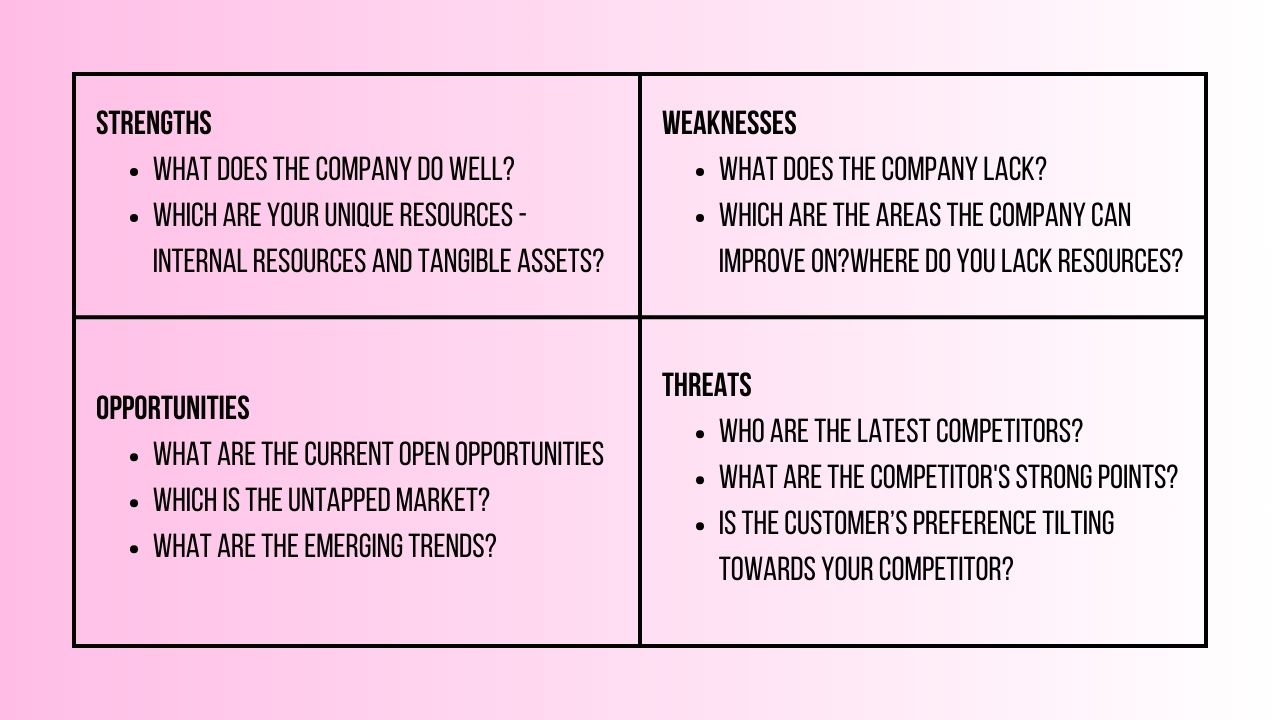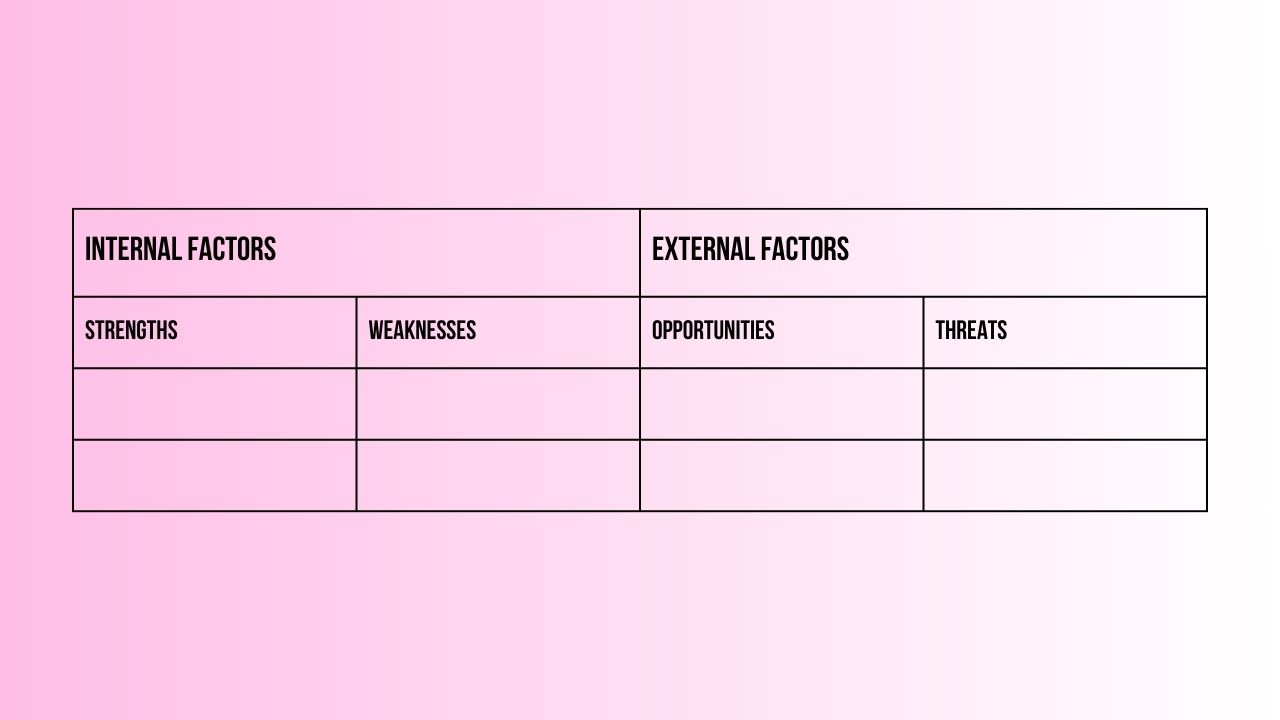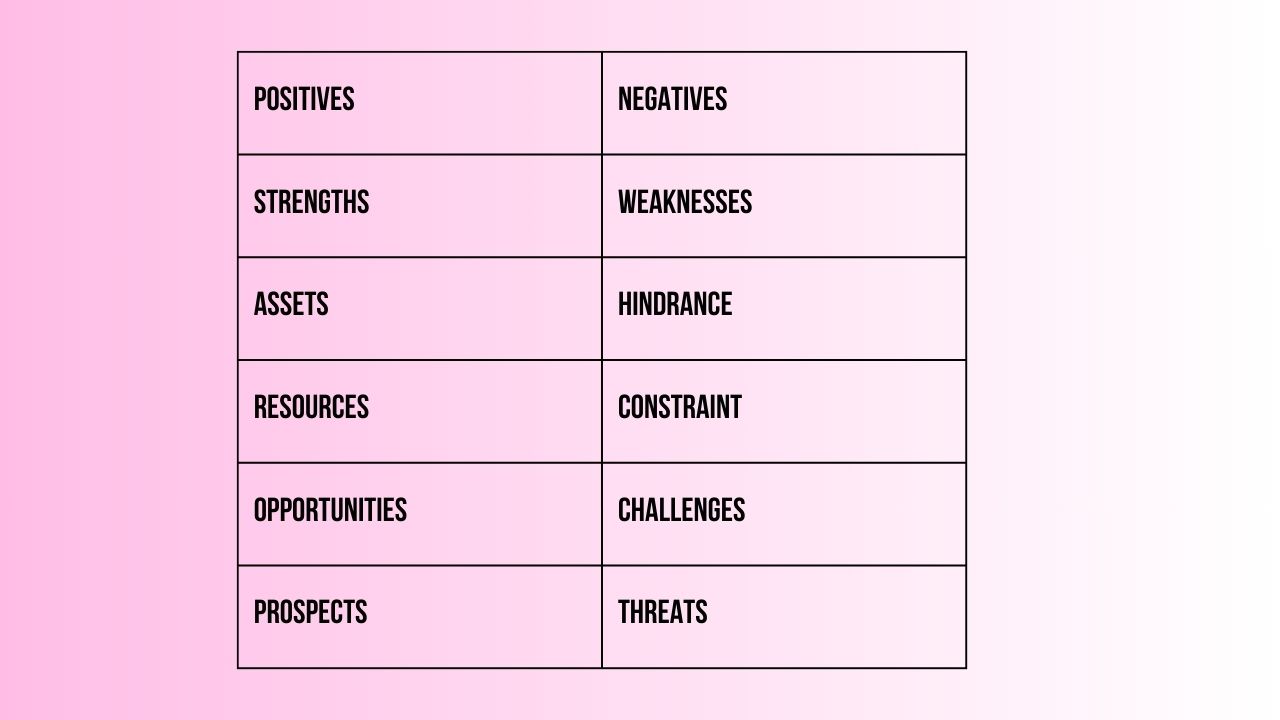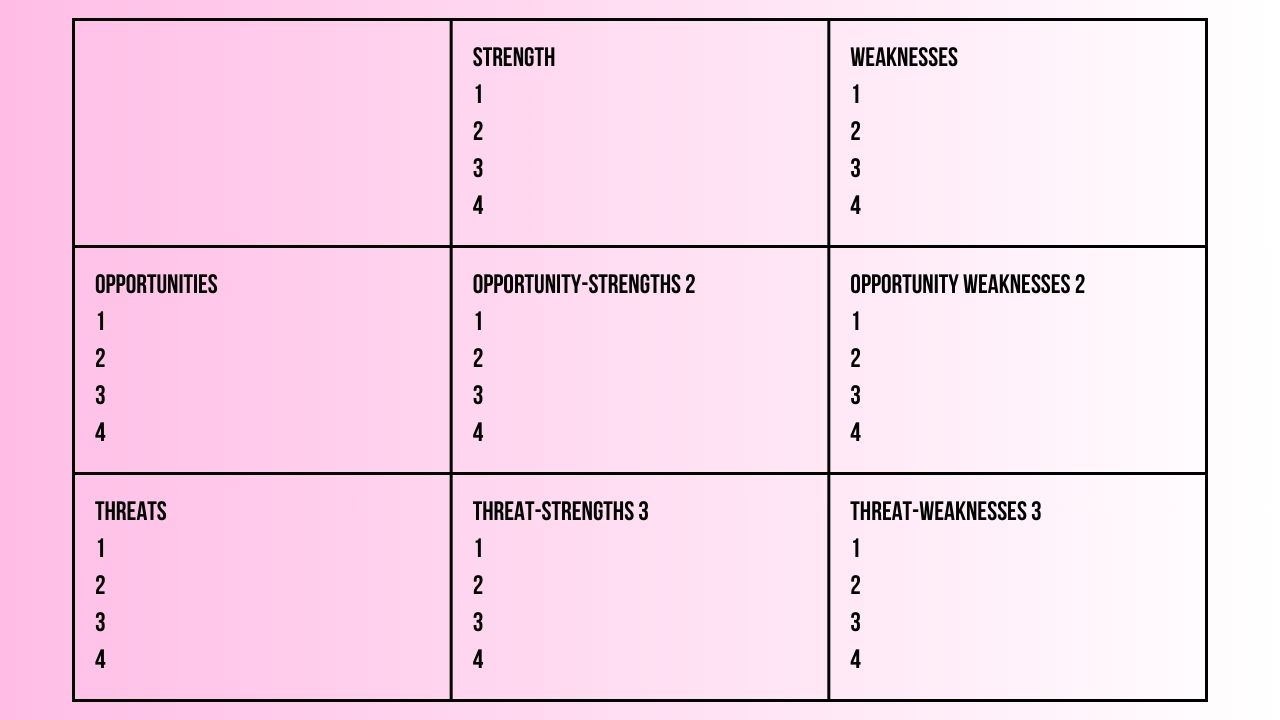Everyone has strengths and weaknesses. But not everyone is aware of them. This is where SWOT analysis templates come in. In this blog, I am sharing how you can perform a SWOT analysis with the help of my templates on yourself or your organization. Let’s go!
I worked for a product start-up. The product created by this start-up was showcased at various conferences and events and always received rare reviews. It was a product ahead of its time, yet the sales figures were low.
Although convinced of their product, the founders conducted a SWOT analysis to address the low sales figures.
Let’s learn how you can do that using my free SWOT analysis templates.
3 Free SWOT Analysis Templates: Your Ultimate Tool to Conduct it
Let’s first understand the acronym SWOT. SWOT stands for Strengths, Weaknesses, Opportunities, and Threats.
This brings us to the question: What is a SWOT analysis and what is its purpose?
What is a SWOT Analysis?
A SWOT analysis is a strategic planning framework for evaluating your strengths, weaknesses, opportunities, and threats.
It is not only used for a single project, small businesses, product, or the entire organization but can also be used for personal purposes.
It helps determine the competitive position and develop strategic planning to analyze internal and external factors and current and future potential.
This way you can enjoy the competitive advantage by learning which area of business needs improvement. This will let you work on them and stay ahead of your competitors and the market trends.
To analyze the strengths, SWOT analysis uses information from internal sources of the project or organization and external sources that may have an uncontrollable impact on decision-making.
Now, let’s see how SWOT Analysis goes beyond just listing your Strengths, Weaknesses, Opportunities, and Threats.
4 Pillars of SWOT Analysis
SWOT analysis is meant to evaluate the strategic position and market environment. It helps you understand the internal and external factors impacting the business.
The results of the analysis will help you to formulate a strategy that will work in your favor.
There are four pillars of SWOT analysis, also known as Elements of SWOT Analysis.
While strengths and weaknesses are a part of the internal factors, opportunities and threats comprise the external factors.
Let’s see what they are and the role they play.
1. Strengths
A quality or attribute that gives a company, product, or individual a competitive edge over its opponent falls under strengths.
Internal resources, product features, tangible assets, etc., are the strengths of the organization, product, or project. You should utilize them to the maximum to achieve the best results.
Both organizations and individuals often find it difficult to list down their strengths. Therefore, it is recommended that a simple list of characteristics be created to find the real strengths.
Here are some examples of strengths:
- Advanced technology enhancing production, speed, and accuracy
- Good customer and supplier relation
- Exceptional talent pool
- Unique brand identity
- Tangible assets like patents, proprietary technologies, etc.
2. Weaknesses
The next pillar in SWOT Analysis is Weaknesses.
This pillar causes businesses to turn inward and find shortcomings critical to their company, product, project, or themselves, that are limiting their ability to perform better.
These shortcomings could be related to resources, skillsets, process hygiene, etc.
While evaluating the weaknesses, the strengths are also evaluated to see any downside of a strength making the organization weak.
This evaluation is further used to improve areas crucial for the business’s success.
Let’s turn your attention to some examples of Weaknesses:
- Inadequate flow of capital
- Lack of trained manpower
- Customer and supplier management challenges
- Lack of creativity and, therefore, innovation
- Insufficient marketing and advertisement
3. Opportunities
Opportunities are the external impetus for your business to increase sales and revenue and earn more profit for yourself.
They are used to formulate strategies to have a competitive edge over opponents.
Opportunities include sales opportunities in untapped or tapped markets, new products, enhanced features in existing products, and the latest technological know-how.
The organization analyses the opportunities to derive maximum profit, growth, and/or efficiency.
Here are some examples of opportunities:
- Foray into untapped markets and market segments
- Advantage over competitors helping in newer customer acquisition
- Newer technologies
- New products and/or features
4. Threats
Threats include external or internal factors that significantly leave a negative impact on your business.
These include prevalent market conditions, government regulations hampering growth, competitors’ better products, etc.
Depending on the threats, the organization will face challenges in reaching its full potential.
Some examples of threats include:
- Changes in customer behavior
- Increase in prices of cost of raw materials
- Intense competition in the product market
- Supplier issues
What are the Benefits of SWOT Analysis?
SWOT analysis is a methodical process for evaluating a situation.
It can help you in decision-making and identify opportunities that were not previously identified.
Although brainstorming brings out new ideas, SWOT Analysis gives detailed insights by identifying the smallest to largest aspects of the business.
This information is divided into four different areas, giving a better understanding of the situation.
In my opinion, the most important benefit of SWOT Analysis is that it makes collaboration possible for every partner.
It paves the way for each person to bring their unique perspective to the table.
Therefore, when further plan of action is charted, all ideas are put together to help the organization march towards success.
A pro tip is to have a relaxed, constructive, friendly setting for more comprehensive, truthful, and insightful analysis.
What is the Purpose of SWOT Analysis?
A SWOT analysis is to facilitate a realistic, data-driven, fact-based analysis of an organization’s or project’s strengths and weaknesses.
SWOT analysis should be carried out unbiasedly, without any preconceived notions, and focusing on real-life contexts.
In the case of an organization, when a diverse population provides data, the results are better. The analysis’s findings are integrated to support impending decision-making or problem-solving.
A point to always remember while carrying out a SWOT analysis is to use it as a guide for improvement, but not as a prescription.
It lends you a fresh perspective and new ideas.
How to do a SWOT Analysis?
A SWOT Analysis consists of a 2X2 grid matrix, with 1 square dedicated to each of the four aspects of SWOT.
You will find questions about the specific aspect on top of the matrix in each square. You will see them in detail in my SWOT analysis templates next.
Who Creates SWOT?
The SWOT analysis team includes team members, project managers, or other stakeholders participating in decision-making and strategic planning.
It should be a collaborative and inclusive process.
At this stage, I would like to give you an important tip. It does not matter who is part of the SWOT analysis team; the greater the number of members and stakeholders, the better the analysis’s findings.
Every individual or group will have a different perspective, which will lend better credibility and results.
11 Important Steps for Developing SWOT Analysis
- Select a leader and his subordinates with good listening and communication skills.
- Record every point that comes up during the discussion
- If it is a larger group, divide the group into smaller teams and ensure every team member is an active participant.
- Give the group a stipulated amount of time for brainstorming. Ask the group to note down all the points that come up during the discussion.
- Gather the entire team again
- Record the points in the S-W-O-T sections
- Identify the strongest contender in each of the SWOT sections
- Open the forum for discussion
- Come to a conclusion and align the conclusion with the envisaged goal
- Create an action plan using the right strategies
- Prepare a summary of the analysis and share it with the entire team. This will help the team with future planning and implementation.
Here are my SWOT Analysis Templates to help you to understand the matrix better.
3 SWOT Analysis Templates
Here are 3 SWOT analysis templates depending on the end goal of your entire analysis:
Template 1:

Template 2:

For better brainstorming and identifying issues, the matrix can loosely be divided into positives and negatives, as shown in the table below:

Template 3:
The next template is the TOWS Matrix from Fred David’s work on Strategic Management. It is more useful for larger organizations or projects and requires detailed planning.

1 – Use the strengths to make the most of the available opportunities
2 – Use the opportunities to overcome weaknesses
3 – Avoid threats with the right use of strengths
4 – Avoid threats and reduce weaknesses
These SWOT analysis templates positively use both strengths and opportunities. When used correctly, threats turn into opportunities, which the organization can use to its advantage.
When Should You Use SWOT Analysis?
The beauty of a SWOT Analysis is that it always brings a new perspective to the table, regardless of the stage we are on. Hence, it can be used at any point to find a new line of thought or validate the existing thought process.
The scenarios you can use SWOT Analysis for include:
- When you want to explore new possible solutions for an existing issue.
- When you want to decide your course of action and choose the best path.
- When you want to find and bring about a change.
- When you want to make changes mid-way after identifying an opportunity with added benefits.
How to Use SWOT Analysis Outcomes?
A SWOT analysis brings a better understanding of the factors affecting your business. With this understanding, the organization is better placed to:
- Create a plan of action
- Select the areas that need help
- Create tangible goals
Factors That Do Not Fall Under SWOT Analysis Purview
When carrying out the analysis, there will be a number of factors over which an organization, project, etc. will have no control.
Making a list of these factors before you start the analysis will get you more accurate results.
Some of these factors are:
- Future trends in the field of work
- Economical trends
- Fund inflow
- Physical environment
- Changes in rules and regulations
What is the Importance of SWOT Analysis?
A SWOT analysis is important for identifying risky assumptions and dangerous blind spots.
It also gives you new insights into the current business scenario and helps develop the right strategy for any situation.
The strength of SWOT Analysis lies in the fact that both internal and external factors are evaluated in the analysis.
The 3 points of importance of SWOT Analysis are:
- Identify areas of opportunity
- Identify areas of improvement
- Identify risk areas
Let’s understand them one by one:
a. Identify Areas of Opportunity
Many companies, especially, miss out on finding opportunities for growth. SWOT Analysis gives them a starting point, which they can use for improvement.
An opportunity could be adding a feature or a product to gain an edge over competitors. It could also mean internally changing the team’s workflow to get more done in less time.
b. Identify Areas of Improvement
SWOT analysis is known to identify small to large issues in sales and marketing strategy, product development, team structure, etc.
After identifying the areas for improvement, a SWOT analysis can be used to brainstorm an action plan to avoid mistakes and take strides toward success.
c. Identify Risk Areas
Many stakeholders miss the point of knowing areas of risk. Taking calculated risks helps arrest problems before they become monstrous. A SWOT analysis helps you stay on top of the game when venturing into risk areas.
Examples of SWOT Analysis
Let’s use my previous organization’s example. Although the product they had built had received rave reviews, there were certain blindspots they weren’t aware of.
When the blindspots were uncovered, they could straighten out the issues and increase their revenue.
At the same time, they also found an area they had overlooked, which cost them a massive opportunity. As soon as they fixed the missing part, they saw a huge jump in their sales.
Let’s go back to the results of the SWOT analysis brought to my previous employer. They found a market segment they had not targeted in their sales bid.
Their product lacked basic functionality, which was a MUST. They also understood they were not highlighting some features that made their product stand out in the competition.
Conclusion
The ever-changing market scenario requires you to be on your toes all the time.
A SWOT Analysis gives valuable insight into the advantages the organization, project, or individual has over its competitors and the disadvantages it faces.
Using the analysis, you can work towards reducing your weaknesses and capitalizing on the advantages.
Although strengths and weaknesses are touted as internal factors, taking perspectives from outsiders may also bring forward a different view altogether.
You should take the opinions of your clients and suppliers into account for better understanding.
To help you deal with this feedback, you can read my next guide on constructive criticism and learn how you can use it to your advantage.



